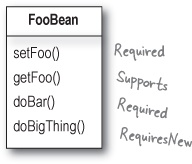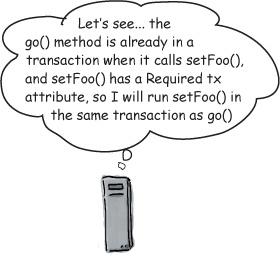How attributes work
Mark a method with one of six transaction attributes:
Required
RequiresNew
Mandatory
Supports
NotSupported
Never

When the method is called, the container uses the attribute to do one of five things:
Run the method in the caller’s transaction.
OR
Suspend the caller’s transaction and start a new transaction.
OR
Suspend the caller’s transaction and run the method without a transaction.
OR
Throw an exception because the caller does not have a transaction.
OR
Throw an exception because the caller does have a transaction.
void go() { aFooBean.setFoo(); }

Know your attributes
How an attribute affects behavior depends on one thing:
Is the calling method in a transaction?

Method foo() is in a transaction (tx A).

Method bar() is marked with the Required transaction attribute.
<method> <ejb-name>MyBean</ejb-name> <method-name>bar</method-name> </method> <trans-attribute>Required</trans-attribute>
Note
The bar() method runs in the same transaction as foo() because bar() is marked Required and foo() has a ...
Get Head First EJB now with the O’Reilly learning platform.
O’Reilly members experience books, live events, courses curated by job role, and more from O’Reilly and nearly 200 top publishers.

